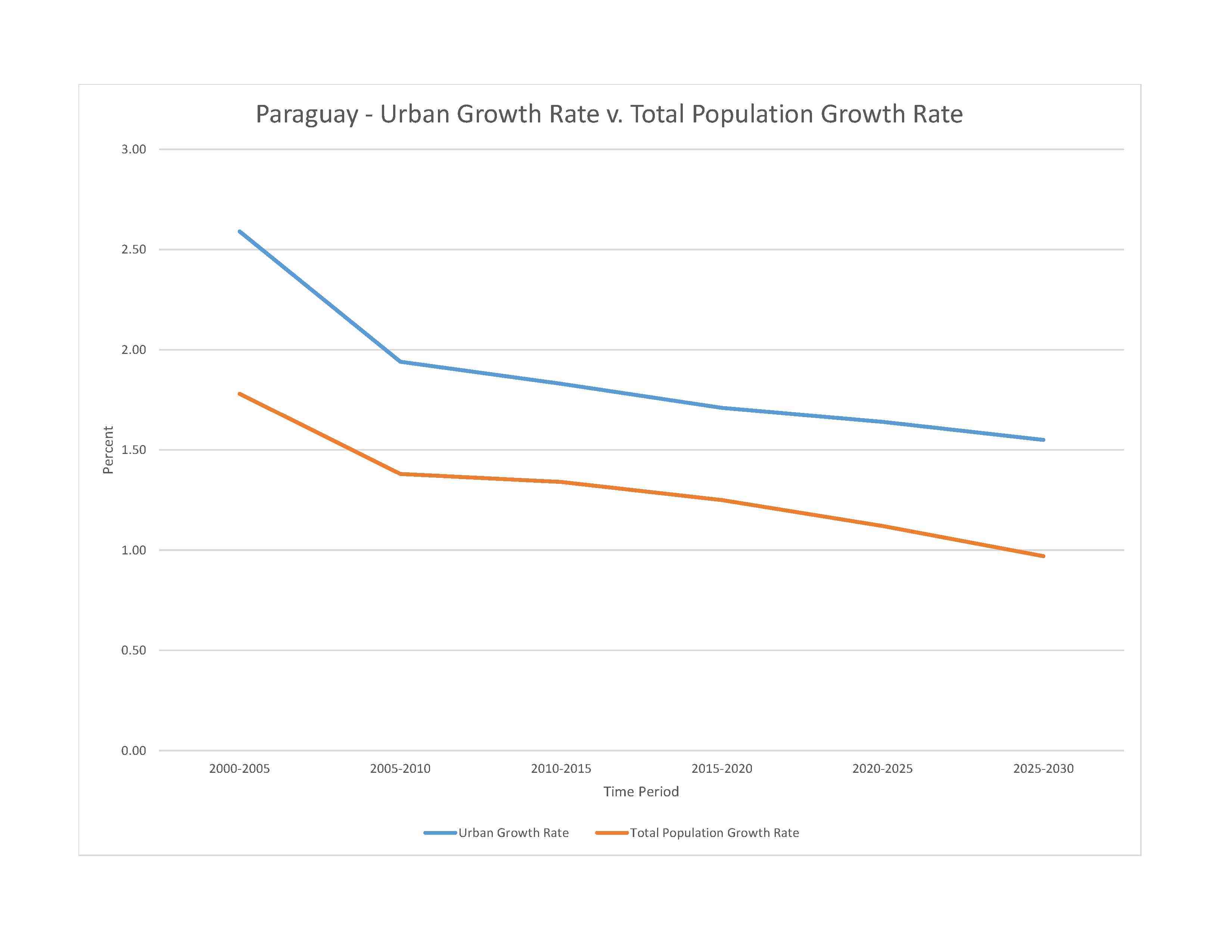
7,439,863 (2023 est.)
noun: Paraguayan(s)
adjective: Paraguayan
Mestizo (mixed Spanish and Amerindian ancestry) 95%, other 5%
Spanish (official) and Guarani (official) 46.3%, only Guarani 34%, only Spanish 15.2%, other (includes Portuguese, German, other Indigenous languages) 4.1%, no response 0.4%; note - data represent predominant household language (2012 est.)
major-language sample(s):
La Libreta Informativa del Mundo, la fuente indispensable de información básica. (Spanish)
The World Factbook, the indispensable source for basic information.
Spanish audio sample:
Roman Catholic 80.4%, Protestant 7% (Evangelical (non-specific) 6.7%, Evangelical Pentecostal
Paraguay falls below the Latin American average in several socioeconomic categories, including immunization rates, potable water, sanitation, and secondary school enrollment, and has greater rates of income inequality and child and maternal mortality. Paraguay's poverty rate has declined in recent years but remains high, especially in rural areas, with more than a third of the population below the poverty line. However, the well-being of the poor in many regions has improved in terms of housing quality and access to clean water, telephone service, and electricity. The fertility rate continues to drop, declining sharply from an average 4.3 births per woman in the late 1990s to about 2 in 2013, as a result of the greater educational attainment of women, increased use of contraception, and a desire for smaller families among young women.
Paraguay is a country of emigration; it has not attracted large numbers of immigrants because of political instability, civil wars, years of dictatorship, and the greater appeal of neighboring countries. Paraguay first tried to encourage immigration in 1870 in order to rebound from the heavy death toll it suffered during the War of the Triple Alliance, but it received few European and Middle Eastern immigrants. In the 20th century, limited numbers of immigrants arrived from Lebanon, Japan, South Korea, and China, as well as Mennonites from Canada, Russia, and Mexico. Large flows of Brazilian immigrants have been arriving since the 1960s, mainly to work in agriculture. Paraguayans continue to emigrate to Argentina, Brazil, Uruguay, the United States, Italy, Spain, and France.
0-14 years: 22.4% (male 847,721/female 818,983)
15-64 years: 68.54% (male 2,560,031/female 2,539,378)
65 years and over: 9.06% (2023 est.) (male 320,958/female 352,792)
total dependency ratio: 54.4
youth dependency ratio: 44.8
elderly dependency ratio: 9.6
potential support ratio: 10.4 (2021 est.)
total: 31.3 years (2023 est.)
male: 31.1 years
female: 31.5 years
1.12% (2023 est.)
16.2 births/1,000 population (2023 est.)
4.9 deaths/1,000 population (2023 est.)
-0.1 migrant(s)/1,000 population (2023 est.)
most of the population resides in the eastern half of the country; to the west lies the Gran Chaco (a semi-arid lowland plain), which accounts for 60% of the land territory, but only 2% of the overall population
urban population: 63.1% of total population (2023)
rate of urbanization: 1.64% annual rate of change (2020-25 est.)

3.511 million ASUNCION (capital) (2023)
at birth: 1.05 male(s)/female
0-14 years: 1.04 male(s)/female
15-64 years: 1.01 male(s)/female
65 years and over: 0.91 male(s)/female
total population: 1.01 male(s)/female (2023 est.)
22.9 years (2008 est.)
note: data represents median age at first birth among women 25-29
71 deaths/100,000 live births (2020 est.)
total: 22.6 deaths/1,000 live births (2023 est.)
male: 26.8 deaths/1,000 live births
female: 18.2 deaths/1,000 live births
total population: 78.6 years (2023 est.)
male: 76 years
female: 81.4 years
1.88 children born/woman (2023 est.)
0.92 (2023 est.)
68.4% (2016)
improved: urban: 100% of population
rural: 100% of population
total: 100% of population
unimproved: urban: 0% of population
rural: 0% of population
total: 0% of population (2020 est.)
7.6% of GDP (2020)
1.05 physicians/1,000 population (2020)
0.8 beds/1,000 population (2016)
improved: urban: 99.6% of population
rural: 90.6% of population
total: 96.2% of population
unimproved: urban: 0.4% of population
rural: 9.4% of population
total: 3.8% of population (2020 est.)
degree of risk: intermediate (2023)
food or waterborne diseases: bacterial diarrhea, hepatitis A, and typhoid fever
vectorborne diseases: dengue fever
20.3% (2016)
total: 5.47 liters of pure alcohol (2019 est.)
beer: 3.27 liters of pure alcohol (2019 est.)
wine: 0.59 liters of pure alcohol (2019 est.)
spirits: 1.59 liters of pure alcohol (2019 est.)
other alcohols: 0.03 liters of pure alcohol (2019 est.)
total: 11.5% (2020 est.)
male: 18.6% (2020 est.)
female: 4.4% (2020 est.)
1.3% (2016)
59.4% (2023 est.)
women married by age 15: 3.6%
women married by age 18: 21.6% (2016 est.)
3.3% of GDP (2020 est.)
definition: age 15 and over can read and write
total population: 94.5%
male: 94.9%
female: 94.2% (2020)
NOTE: The information regarding Paraguay on this page is re-published from the 2024 World Fact Book of the United States Central Intelligence Agency and other sources. No claims are made regarding the accuracy of Paraguay 2024 information contained here. All suggestions for corrections of any errors about Paraguay 2024 should be addressed to the CIA or the source cited on each page.
This page was last modified 04 May 24, Copyright © 2024 ITA all rights reserved.